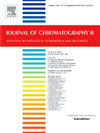
《色譜學(xué)雜志B》發(fā)表了與生物學(xué)和生物醫(yī)學(xué)研究有關(guān)的分離科學(xué)發(fā)展的論文,包括基本進(jìn)展和應(yīng)用。可以考慮的分析技術(shù)包括色譜、電泳和相關(guān)方法的各個(gè)方面、親和力和免疫親和力為基礎(chǔ)的方法、連字符技術(shù)和其他多維技術(shù)以及微分析方法。該雜志還考慮了報(bào)告樣品制備、包括質(zhì)譜分析在內(nèi)的檢測(cè)技術(shù)以及數(shù)據(jù)處理和分析進(jìn)展的文章。與分離純化生物系統(tǒng)成分的制備分離相關(guān)的進(jìn)展可能會(huì)公布,包括色譜和電泳方法、親和分離、場(chǎng)流分離和其他制備方法。當(dāng)分析科學(xué)包含一個(gè)重要的新穎性元素時(shí),將考慮生物系統(tǒng)和樣品分析的應(yīng)用,例如化合物分離的新方法、分析技術(shù)的新組合或顯著改進(jìn)的分析性能。需要考慮的領(lǐng)域包括:包括蛋白質(zhì)、單克隆抗體、肽及其翻譯后修飾以及核酸和聚糖在內(nèi)的生物聚合物的定性和定量分析;利用蛋白質(zhì)組學(xué)、基因組學(xué)、代謝組學(xué)、脂質(zhì)組學(xué)和其他“組學(xué)”方法對(duì)生物系統(tǒng)進(jìn)行比較分析;臨床分析、代謝、治療藥物監(jiān)測(cè)、毒理學(xué)分析、興奮劑分析、獸醫(yī)應(yīng)用、生物系統(tǒng)環(huán)境污染物分析;體液、組織、細(xì)胞、生物基質(zhì)和系統(tǒng)的篩選和分析、內(nèi)源性化合物、生物標(biāo)志物;新生物活性化合物的鑒定。使用已出版的或商業(yè)化的分析性或準(zhǔn)備性協(xié)議而很少或沒(méi)有修改的應(yīng)用,或應(yīng)用結(jié)果而不是分析方法構(gòu)成手稿新穎性的主要因素的應(yīng)用,應(yīng)定向到更專(zhuān)業(yè)的期刊。在性能顯著改善的情況下,可以考慮對(duì)先前發(fā)布的方法進(jìn)行修改,以便進(jìn)行簡(jiǎn)短的溝通。關(guān)于藥物開(kāi)發(fā)早期化合物分析方法的報(bào)告往往缺乏普遍興趣,除非作者能夠證明所涉及方法的更廣泛意義,否則不會(huì)發(fā)表。散裝藥物、天然產(chǎn)品或小分子藥物制劑的質(zhì)量控制分析不在范圍內(nèi)。
The Journal of Chromatography B publishes papers on developments in separation science relevant to biology and biomedical research including both fundamental advances and applications. Analytical techniques which may be considered include the various facets of chromatography, electrophoresis and related methods, affinity and immunoaffinity-based methodologies, hyphenated and other multi-dimensional techniques, and microanalytical approaches. The journal also considers articles reporting developments in sample preparation, detection techniques including mass spectrometry, and data handling and analysis.Developments related to preparative separations for the isolation and purification of components of biological systems may be published, including chromatographic and electrophoretic methods, affinity separations, field flow fractionation and other preparative approaches.Applications to the analysis of biological systems and samples will be considered when the analytical science contains a significant element of novelty, e.g. a new approach to the separation of a compound, novel combination of analytical techniques, or significantly improved analytical performance. Areas to be considered include:The qualitative and quantitative analysis of biopolymers including proteins, monoclonal antibodies, peptides and their post-translational modifications as well as nucleic acids and glycansThe comparative analysis of biological systems using proteomics, genomics, metabolomics, lipidomics and other "omics" approachesClinical analysis, metabolism, therapeutic drug monitoring, toxicological analysis, doping analysis, veterinary applications, analysis of environmental contaminants in biological systemsThe screening and profiling of body fluids, tissues, cells, biological matrices and systems, analysis of endogenous compounds, biomarkersIdentification of new bioactive compoundsApplications which utilize published or commercial analytical or preparative protocols with little or no modification or where the results of the application rather than the analytical methodology comprise the major element of novelty of the manuscript should be directed to more specialized journals. Modifications to a previously published method may be considered for a short communication in cases where the improvement in performance is significant. Reports of analytical methods for compounds in early pharmaceutical development often lack general interest and will not be published unless the authors can demonstrate the broader significance of the methodology involved. Quality control analyses of bulk drugs, natural products or pharmaceutical formulations of small molecules are not within scope.
SCI熱門(mén)推薦期刊 >
SCI常見(jiàn)問(wèn)題 >
職稱(chēng)論文常見(jiàn)問(wèn)題 >
EI常見(jiàn)問(wèn)題 >